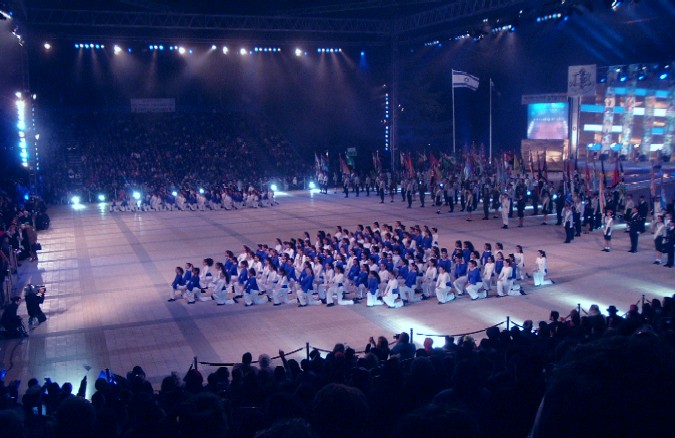Some Chanukah-Oriented Activities / Peulot
-
Please see our other sections for background, material and vocabulary that you can use in the below (or to create other lessons and activities out of).
-
Many of these activities can be used at home as well as in school or a youth group.
-
Most of the below can be adjusted for older or younger, made simpler or harder, etc. Where there's a more likely age range, this is specified within the peula / activity instructions.
- Confessions of a Sevivon Shark
- Sevivon Maccabiah
- Calling All Spin-Doctors
- Chanukiah Challenge - Tap Your Crazy Inner-Artist
- Chanukiah Collage & Sevivon Mobile
- Feliz Januca! (piñatas!)
- Take Back the Season With Ivrit
- Whadjasay?
- What I Love About Israel
- What A Blessing!
- The Great Latke-Hamantash Debate
- The Magic of Stained "Glass"
- A Little Light Dancing & More
- A Super Sing-Off
Confessions of a Sevivon Shark
Really, when you think about it - what can beat a little holiday that has speed and thrills, fire and light, heroic tales, fat, salty and sweet all rolled into one? We turn now to the speed and thrill part - spinning and games-of-chance (all while noshing on the other elements)…
Traditional game, for all ages:
You could play with tokens - like beads for example - redeemable for m&m's, nuts, penny-candy, caramel popcorn and what-not, to keep things a bit cleaner than all the passing around of the food. Or use Hershey kisses, unshelled peanuts, pistachios, etc.
If playing with an older crowd (like high school), we've sometimes used pennies and small change (which you need since the pennies add up). ***But if in a school or youth group as opposed to home, first make sure to get signed permission slips from parents well ahead of time and set a definite limit, on the low side- like $2-3 total allowable to bring (in two decades, never even once had a problem with permission, by the way).
We've had some ad hoc family traditions develop, starting with sort of accidentally collecting sevivonim through the years. Like we'd see nice, different, interesting ones, plus of course a bunch of the usual simple kinds in many colors already…we started keeping them together in a box, and we'd pull out this cool collection for our varied games at home or school. In this case, each player gets the added option of choosing whichever sevivon one prefers from the pile each turn – it adds to that "on a roll" or "change your luck" element.
Rules:
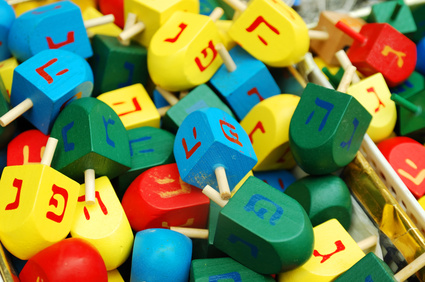
- To determine who goes first, everyone spins a sevivon simultaneously. Those who get a gimel spin off against each other until you are down to one winner. Starting from that winner, play continues going to the left (just because we are a Hebrew enterprise ;-) of course).
- Everyone contributes two tokens to create a starting pot.
- Each time thereafter, before the next person takes a turn, all contribute one token to the pot.
- Gimel = give the winner the whole pot.
Hey = take half of the pot.
Nun = nuthin' happens.
Shin = oh shucks, pay the pot.
There's a few ways to handle cost on that shin-roll. Decide to pay an arbitrary set price of one or a few tokens. Or that the rule will be to pay all you have, or half of what you have, etc. Keep it gentler and small for younger children. And maybe let them know there's a little surprise after the game and then let them all pull a dollar-store "prize" out of a bag so that everyone is a winner (or turn to the Feliz Januca piñata activity below). With older kids use your best judgment knowing your group, and if you deem appropriate, allow them to decide the pay rule together themselves.
If you are dealing with a very large class, obviously split them up into smaller groups to play.
*To be fair, we'll also confess to an adult-level variation of this game, though we don’t want to create any too-serious sevivon sharks, ok?:
Our family's adults would look forward to this every Chanukah - like on par with a once-a-year "wild" trip to Atlantic City slot machines (ok, we kept a ridiculously low-limit rule on that too; besides, the only houses we'd bet were the "Monopoly"-board kind). The total amount that each person could play was in the realm of $10 or so worth of change, starting off with pennies. They really add up fast though, especially with 5-10 players, so don't come with too many. At any point in the game, before a player would spin, she could declare that she was upping the ante (the per-turn contribution) by one more cent from then on. That might not sound like much. But if you have ten people playing, every one cent added means each person is putting some multiple of 10 cents in the pot (depending on how many up-the-ante's have occurred) just to get to their turn to play. So that's dollars in the pot sometimes growing fairly rapidly, depending on how the sevivon has been falling lately. Anyone could leave the game at any point. Yes, embarrassingly someone could get really lucky and sometimes clean up to the tune of about $50 or so this way - all based on the dumb luck of a sevivon + how many participants you have going + for how long. Usually whoever scored big in the end then ordered everyone pizza or something, and/or contributed at least part of the winnings to a preferred tzedaka cause.
Back to top ⤴Sevivon Maccabiah
We have an international Jewish athletic Maccabiah event (like Jewish Olympics) every four years here, so what's more natural than a Sevivon Maccabiah? Because you know you have to have spin contests. So pull out that sevivon collection! Below are a few suggestions. Have your students try to brainstorm even more.
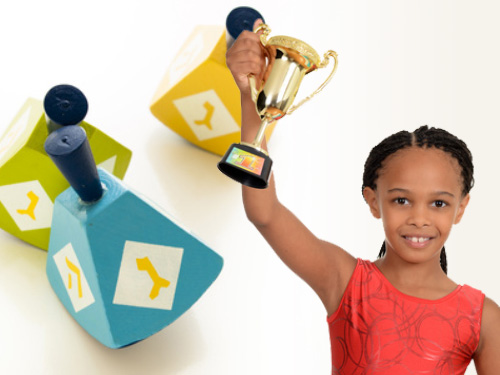
- Everyone chooses a sevivon and starts spinning at the same time. This is a contest of both best sevivon in the collection as to spin longevity, and skill of person spinning it.
- Who can get the most sevivonim spinning at one time, before any of them drop?
- Try to knock down the other side's sevivonim without your own falling too. You start at the same time and get as many spinning as quickly as possible from one shared common pile. You want to be the last guy standing.
- Last-guy still standing contest and/or knock-out contest (for only 1-4 sevivonim per side) in a restricted space- by using a largish empty drawer or tray.
***The only thing is be sure in these contests that there's no dawdling in spinning that last sevivon, because obviously that would be an unfair advantage for last-guy-standing. If necessary, set a limit of x number of seconds for all launching. Like the class could chant a countdown in Hebrew starting from eight! In that case, you can also have a set number of sevivonim available for each side - they just have to use them all up in time. - It's just amazing - these swift whips who so effortlessly flip their sevivonim up to spin on the stem. You have to hold the stem from an upside-down position and give it a twist while popping it straight up in the air, so that it lands well enough on the stem (and get your hand out of the way). There's another contest for you.
- One son, when very young, went through a major spinning fascination set off by Chanukah. Everything in the house became an impromptu lab test for its spin-worthiness. This tot even set off the bug in all of us, which we now pass to you. Give your kids a mission to go through their home and check all junk and toy pieces. You can even make it a contest challenge. They bring in their best and/or goofiest spin-success samples ;-). You'd be surprised what can spin when you set your mind to it. (Yes, fruits and veggies allowed too). Pit them against each other to see what spins the longest. And if it's lucky enough to be something you can put dot labels on with the traditional letters that falls to one side or another, all the better.
- Of course there's "who can be whirling dervish the longest". We'd be remiss not to include that one. Do it to Chanukah music. (If you are snacking, plan on doing that after such spinning, not before.)
*You could alternatively have a more variegated Maccabiah or party-type "event" by including a few more peulot/activities from below, like "Chanukiah Challenge", "A Super Sing-Off", "Whadjasay", etc.
Back to top ⤴Calling All Spin-Doctors
There's a plethora of make-a-dreidel directions online nowadays (even Martha Stewart got into the act). In this instance we are using the Yiddish term dreidel since that clearly gets you further with Google. You'll find what strikes your fancy faster if you search via Google images, by the way.
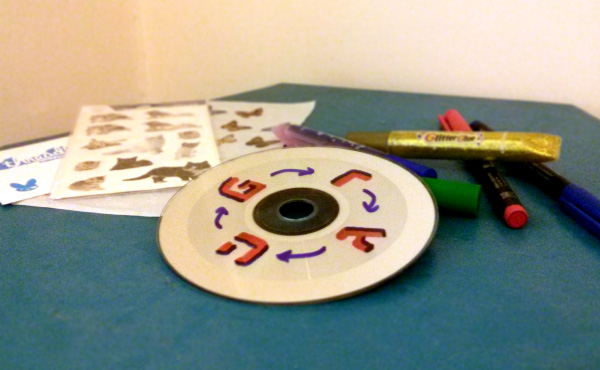 A dreidel in the making...
A dreidel in the making...We certainly have a few homemade dreidels in our collection too. The best easy-peasy one that came home from the kid's gan/kindergarten (and it's held up for years) beats those ubiquitous milk carton + pencil suggestions by a mile:
- Get a defunct CD disc, some white glue, a kid's largish bead (~1.5 cm or so wide) or very small rubber ball (or similar roll-y junk/old toy bit) and another larger bead or used sewing spool or something similar. You glue one of those to each side of the CD at the point of the hole, with bead or ball being what you spin on and spool to serve as a stem. Marker on letters with a Sharpie, decorate with stickers or lighter-colored markers and you're set. They spin great and look shiny-pretty while doing so.
- An odder one: there's too many useful things to do with baby bottle rings (that hold the nipple on) to ever get rid of those. It turns out if you jam a small rubber ball into the hole of the ring on the outer side, it spins nicely (e.g. grab the rim part to spin). Add those in your spin contests too. Again, you'd be amazed by what's sitting around your house just waiting to get turned fairly quickly into a spiffy and successful sevivon.
Here's a few more ideas we liked online: - http://www.matzosoup.com/2009/12/our-dreidel-factor.html
This one involves paper strips, glue, and a toothpick. - http://www.estherodesign.com/construct-a-dreidel
Ye olde toothpicks plus gumdrops (or similar penny candy). Very simple, fun, cool. What we played around with before metal balls and magnet rods came along, and the old way is also tasty. - "The edible dreidel": http://chickinthekitchen.com/tag/hershey-kisses
We've seen these everywhere now on the net (the idea has actually been around for decades) - we love it and so have our kids. Pretzel sticks, marshmallows and Hershey's kisses (plus those little icing tubes to add letters if you like). Note that in some versions they use peanut butter for "glue" instead of frosting. If you are dipping in melted chocolate afterwards, that's a nice taste combo. - "The CD spin-art dreidel": http://www.estherodesign.com/spin-art-dreidel
She has a very clever and simple idea with this one. You need an old CD, a marker (an older "going" one is also fine) and a glue gun; plus large sheet of butcher-block type paper to spin/draw on. - *We just add that if you don't want to deal with the glue gun, you or the kids can keep the marker jammed into the CD by wrapping rubber bands around the marker on both sides - after you wrap a band round and round the marker on each side of the CD, push the rounds up to the hole as close and tight as possible. If it's not thick enough, throw on some more rubber bands. (We love lo-tech-what's-handy? fast alternatives).
Chanukiah Challenge - Tap Your Crazy Inner-Artist
If you've seen any of our previous holiday packets, you know how much we love junk and "trash".
On kibbutz we used to have a presentation from each work branch involving either showing a whacky chanukiah of some sort or "performing" a chanukiah tableau-style (with suitable props and materials) that was somehow related to their work. These were always just crazy-creative and wonderfully entertaining. With that thought in mind…
Some sessions ahead of Chanukah, either at school (if you have internet available for the kids) or a mission for home - have everyone Google using the search terms "menorah" or "chanukiah" plus words like "interesting", "different", "wow", "odd", "unusual" or "clever", etc. It's a real eye-opener!
You now can choose what direction you go with this:
- Tell everyone to start bringing in some junk and "trash"- cups, balls, spent toilet paper or towel rolls, boxes, lego or duplo pieces, cloth, other old toy or kitchen junk, T-shirts, newspaper (like for stuffing or paper balls etc. if needed), latex gloves, old pens, busted large costume jewelry…whatever. Once you have a few boxes of this stuff collected, divide the group into teams and give a time limit for how long they have to create chanukiah "sculptures" or tableaus out of their available junk – they are allowed to barter between teams, by the way. This could be as simple (but pretty clever of some previous students) as eight toilet paper rolls topped with assorted balls for flames, plus one towel roll for a shamash – they ran out of balls and used a baseball cap shoved part-way into the tube for the flame on that one! Small size is also fine. If each kvutza/team also has to come up with a cheer or song with their presentation to the class, even better.
- Another option is for them to make a chanukiah sculpture out of their bodies. Or to combine bodies and junk together.
- A third option is that each group chooses a theme that they will base their home junk search attempts and presentation on (somewhat like the described kibbutz version). To be presented the next time that you meet. A theme could be practically anything, from freedom to action heroes to baseball to vegetables – as long as something somehow representational of "chanukiah" comes out of it… (Yet another reason why it's good to have them do the Google images hunt a few weeks before - to set the mentality a bit). Go wild.
While still on chanukiot, we'd like to also throw out this side thought:
Most people see and use the candle versions. You might want to show your class the alternative method - like what was used in the Temple - with oil and wicks. Mention that some chanukiot are designed for this. However, those too poor to own chanukiot in Kurdistan, for example, still fulfilled themitzvah by using washed eggshells - meaning any safe/nonflammable container times nine is fine (we don't suggest eggshells unless you happen to have a lot of egg-cups or play dough or something to hold them really steady).
A Handy Symbol List, Plus…
For all sorts of activities - crafty work and decor, games, etc.
For a simple example, hand out cards with these and each must say something about what that symbol evokes in them. Or one has to write the Hebrew word for the symbol on the board for their team. Or you make a tic-tac-toe of symbols and then each kvutza/team has to name it or write it properly to capture the spot, or play Concentration with symbol cards that match up to word cards, or a "treasure hunt" with clues to find each needed card hidden in the room or some hint about which symbol you need, or…
- chanukiah/ Chanukah menorah
- Sevivon / spinning top
- levivot / potato pancakes (like in a frying pan)
- potatoes, bag labeled flour and eggs
- sufganiot / doughnuts
- shield with a hammer or Magen David (Star of David) on it
- hammer
- Magen David
- candle/s
- simple wick and flame
- jug of oil
- cheese
- the letters מכבי (= Maccabee- it's also an anagram. See our "Good To Know In Hebrew" section)
- the letters נ ג ה ש (outside of Israel), or נ ג ה פ (in Israel)
- coins and a tzedaka box. (By the way, save gold foil from chocolate coins to use in arts & crafts! And you know they also make fine "flames".)
- Temple
- photos of Jerusalem, the Kotel/Western Wall
- photos of something related to Israel – since this is a modern miracle. The very last time we had any kind of autonomous state at all was under the Hasmoneans, close to 2000 years before this.
- ***Please also be sure to see our "Good to Know in Hebrew" section - the Hebrew words are excellent for art projects and games too.
Chanukiah Collage & Sevivon Mobile
In the spirit of a "Green Chanukah" (see more on that in our "Let's Talk About It" section), and because it's lovely-looking too…
Collect patterned, colorful papers- like the leftovers from wrapping paper, old posters, etc. Some magazines have terrific patterns and colors on some of their pages to cut up for this purpose too. The leftovers from Contact paper are also great for this, plus stickers (like the dot kind), aluminum foil bits (you can also save those from food packaging) and the gold foil that the chocolate gelt comes in. In fact, ask your kids to collect stuff at home and/or send a letter request to parents. These are good supplies to collect and use all year.
Create the collage perhaps on somewhat heavier stock paper (preferably colorful and/or darker and/or with some decent contrast to your strips- see below).
You also need scissors, pencil or light marker, ruler and white glue or a glue-stick.
To be prepared beforehand: Cut longish strips from your assorted papers in a variety of widths (e.g. 3/8, 3/4",1+' / 1, 2 & 3 cm.) - for younger kids and those with any special needs.. Older kids can cut strips themselves.
Before starting, draw examples of simple line-rendered chanukiot on the board. Then invite all your kids to all come up to the board and doodle some too! It gets them thinking, sharing and practicing before they hit their sheets.
They will make light simple guidelines on their sheets of a large chanukiah e.g. that fills most of the sheet. Show a sample on a sheet in darker line, so they understand the size before they start. If a child has a motor or all-thumbs issue or too much frustration, help make the guidelines.
They then simply cut strips to more-or-less fit.
Paste each piece into place over the guidelines.
Remind those younger guys that tend to fret that this does not need to be perfect and will still look super. Like if things are rather crooked every which way or mis-sized somewhat in the cuts, it's simply a chanukiah that's so happy already that it can't stay still and is dancin'. (Some abstract artists get paid tons for that anyway.)
Use the shiny and/or foil and/or flame-y colored stuff (or slightly snipped dot labels) for the flames on top (just fold or snip foil coin wrappers a bit to make a flame tip- you maybe just don't want the coin shape used "as is" so that it doesn't look like some "money tree").
Varying the patterns on stems and all will look great too, plus making an outer frame of alternating strips- like a pretty crazy-quilt.
*This isn't just for younger kids. Older youth and/or more adept types can make very classy paper-cut and/or quilt designs. Ask them to bring cuticle shears if they want to get more intricate.
*For tinier tots, they can make a picture also totally out of sticker dots, with you drawing the guidelines or pre-xeroxing sheets with lines.
*For an added personalized flair, ask the kids ahead of time to bring in very small photos of themselves and/or family (yes dogs and cats are good too) and/or friends to add to the collage. Like xeroxed copies or print-outs, to cut and paste on. After all, someone lit those candles and is basking in their glow.
You can use the same method for any symbols or words, of course (see "Handy Symbol List" above).
Create a sevivon mobile:
The three basic shapes that make up a sevivon are simply small square or rectangle + large square or rectangle + a triangle base.
You'll need: pencil, small index cards, shape stencils sized to fit the card (e.g. - cut a card into a sevivon and then into its component three shapes), various patterned-print and/or colorful papers like described above and pre-cut into strips of appropriate widths, scissors, glue, gold coins, markers, ribbon or yarn, hole punch and wire hanger (either a few for class or one per child- you'll have to help the little ones with bending, or prepare them ahead of time).
- Make each shape from a different paper to glue together on the card, or top and bottom the same and the middle something contrasting nicely.
- Cut the excess part of the card away to leave only the sevivon shape- if the sevivon fills the card, which is ideal, then that's six straight simple cuts in total, so a child that has started to master simple tasks with the scissors can usually handle this.
- Now that the sevivon shape has been cut out, glue decorative papers the same way onto the second side of the card. Add a sevivon letter on both front and back. Punch a hole in the stem and hang them all over, string them, or …
- Make a number of these patchwork-style sevivonim and hang them from a wire hanger that you have re-bent into the shape of a large sevivon. Maybe punch a second hole towards the bottom of a sevivon or two so that you can hang another from it. Add a festive touch with more ribbon strands hanging down that you've curled on a scissor edge or ruler :) .
- You can also do the letters in black marker on foil coin wrappers (or leave the letter part shiny and color in the background part on the foil coin) and then glue those on.
Feliz Januca! (piñatas!)
Borrowing from Mexican Jews, why not include a piñata in your Januca party? Fill with goodies etc. If you like, the kids can help decorate it. Then everyone becomes a Maccabee and takes a whack at it while holiday songs are playing or you all sing (use blind-fold if you prefer and if it’s a real flimsy construction). It's a winner peula/activity for any age.
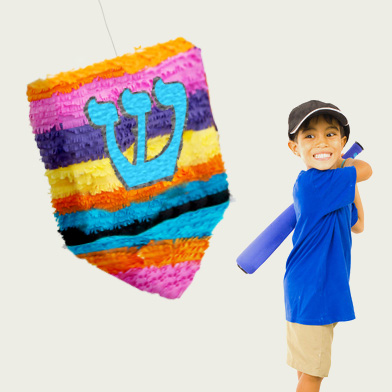
*Just remember if doing this with the very young to use only fillers which are not choking hazards.
Paper Mache Version:
You need …
- regular or large balloon (or old paper lantern or rather thin-whatever)
- newspaper- torn or cut into longish strips ~ 1-2"/2-3 cm. wide
- pot or large bowl & mixing spoon
- flour, water & salt
- masking tape
- string
- scissors or knife or something to poke a hole
- poster paints and brushes (and/or other décor methods)
- filler goodies
There are tons of measured recipes on the net, but we've always done fine just playing it by ear. Simply mix enough flour with water so that your paste will coat a test-paper strip without being too soggy/drippy. Once you have the consistency about right, mix in a pinch of salt. Dip strips in goop and spread onto balloon, with a lot of criss-crossing of strips. Let dry, pop balloon, fill with goodies, punch holes and run through string for hanging. Then seal top with lots of criss-crossed masking tape. Paint with poster paints, and decorate with simple Chanukah symbols or words in Hebrew.
Here are some fast-ish alternatives we've found also do the piñata trick without resorting to paper mache:
- Decorate a large paper bag (preferably with handles, for sturdier hanging). For example, you can cover it by gluing on tissue or crepe paper and then gluing simple holiday symbols on that. Or use that square shape and strongly tape on a triangle bottom to turn it into a large sevivon shape (i.e.- tape on two triangle cardboard shapes that meet at the tip).
- Use two large sheets of thinner poster board (like cheap-y stuff). Cut out identical circles. Slit each circle about half way or a bit more to the center aka a quarter to a third of the diameter. Fold one edge of the slit slightly over the other and tape tightly with masking tape on both sides. The idea being when the circles are put together it's a bit pouchy for holding goodies, sort of like a pita. Decorate the outer side of each circle like a Maccabee shield, or with festive symbols, or an Antiochus effigy, etc. Tape outer edges of the 2 circles together almost all the way, fill with goodies and then finish sealing. Hole-punch in 2 spots at top to run string though and hang.
-
Use two large cereal boxes or other flimsy cardboard container. One box will be the base which holds the goodies. The other gets used for its cardboard to masking-tape on a triangle-shaped bottom of your sevivon. Punch a hole near top of box front and back to run your hanging string through. Fill and tape top of box shut well. Cover with something nice that you glue on or stick it in some old wrapping paper leftovers and decorate further with Hebrew letters, etc. if you like.
-
***How to use a stronger box, if that's what you've got or need something slightly larger (e.g. corrugated, but not too large, ok?): You weaken it structurally ;-) . Undo the flaps. Cut off the four shorter-side ones. Tape shut the two remaining flaps on one side with masking tape - but do NOT do so in one long continuous strip! Rather, shut the flaps using 3-4 strips, leaving a 1-2"/2-3cm gap between each strip. Because we aren't recreating Fort-Knox - we want them to be able to bust the thing open and within a reasonable period of time, right? Punch 2 holes front and back at top of box and run hanging string through. Fill with candy and or stickers, little cheap toy stuff, key rings, that sort of thing. Tape the other side's two flaps shut the same gapped way as above. Glue on an appropriate symbolic picture or write a pretty Chanuka sameach! חנוכה שמח on at least one side. Decorate the rest typical piñata-style by overlapping tissue or crepe-paper strips (width of about 3"/7cm. that you've cut to make it fringed (1/2-2/3 of width), which you can attach with white glue or even a glue-stick.
(We've seen these piñatas used at parties with children with heavier special needs, by the way. Even where kids needed help of some kind [sometimes in a mixed group, one more able-bodied child paired off and aided the other child] the whole thing was an inclusive thrill for every child - a proven especial crowd-pleaser.)
Back to top ⤴Take Back the Season With Ivrit
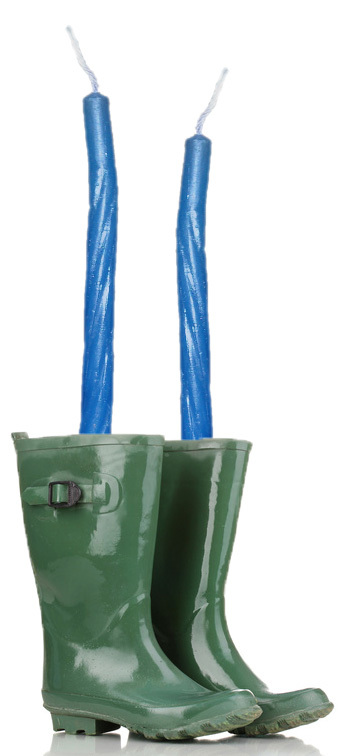
We're well aware that in many communities, Ivrit/Hebrew is taught mostly for reading skill at prayers. But teaching some regular daily-life vocabulary and phrases can liven things up while helping along that goal (and getting the ear and mouth more exercised and 'acclimated' too). It can also help strengthen connection with Israel somewhat - like for when you visit us! Kids also often think it's cool when someone knows at least a bit of a foreign language, so you can hype that angle. Further, Hebrew simply tends to add some more helpful glue in Jewish identity and ties. This is especially true if you can keep it positive, enjoyable and broken down well into smaller tasks and goals (it also helps if you are a good cheerleader, pitchman and can slip more Hebrew bits in here and there in any topic). Even if the child won't become a quasi-Hebrew speaker from your school, if the experience wasupbeat and a more regular part of the general atmosphere, they may be more apt to pursue it seriously later. (Think about the model of positive Jewish summer camp experiences in this regard).
So… during this flashy winter season, why not work on some pertinent seasonal vocabulary? We've included some wintry weather words in our "Good To Know In Hebrew" section. These can be made into little reminder posters around the room, and then make it a ritual to mention or ask about weather conditions in Ivrit each time your group meets. Additionally, if you are in the Northern Hemisphere, you are all bundled up much of the time - so you can make that into a silly game of "Off-On" using some of this suggested vocabulary:
- sveder סוודר sweater
- jaket ז'קט jacket
- me-il מעיל coat
- tze-if צעיף scarf
- magafaim מגפיים boots
- garbaim גרביים socks
- naalaim נעליים shoes
- kefafot כפפות gloves
- kova כובע hat
- lilbosh ללבוש to dress, to put on
- lehorid להוריד to take off
We suggest only using four vocabulary words at a shot to play with (you can switch the words after a while). You could also use that sevivon ;-) : Just cover the letters with taped-on paper and put a vocabulary word on each side. There's no winner or loser, it's just a goofy fun drill.
Or play Shimon Omer (Simon Says): Shimon omer lilbosh ___, and Shimon omer lehorid ___.
When the kids get better at the words, they themselves can take turns being Shimon. For a girl as leader, one could say "Simona omeret…"
Too much sitting down in class is not good. These sorts of simple short exercises keep you learning while moving around a little too. Also, frequent very short-burst "drills" (the fun kind) can sometimes work better than one long bout, so a sudden 2-4 minute session of Off-On done twice each time you meet (they never know when!) - or whatever you are working on reworked as a quick surprise game drill - that can get you further than you'd think.
*Being able to count from 1 to 10 in Hebrew is especially useful around this time. Teach them counting down too- you can then add that "atmospheric" to all sorts of fun stuff, right? So be sure to check out numbers plus some other useful vocabulary offered in multimedia format in our Free Collection here:
http://www.learnhebrewpod.com/free-hebrew-lessons
Whadjasay?
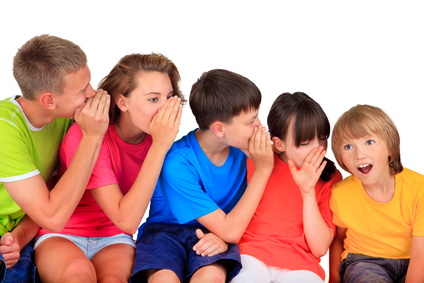
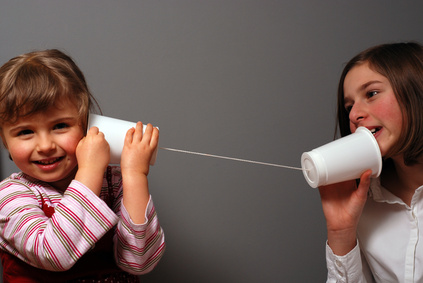
For working on Hebrew and/or Chanukah vocabulary words:
- Play Whisper-Down-the-Lane with a word, phrase, or song line.
- Take turns in teams saying the word through that telephone you make out of the cup/can and string. You might want to do it in a real long hallway. Lo- tech is still cool, honest (that magic and curiosity factor).
- Guess the word by reading the teacher's lips. (For any guttural letter, point to your throat).
- I Need My Mates: Review some words. Perhaps also write them on the board, if not already posted up in the room as "legal cheat sheets" for your studies ;-) . Tell each child one syllable (if they can't read) or hand them a card. Then let them loose to run around saying and/or showing their syllable, trying to find mate/s to make one of the words.
E.g. cha nu ki ah se vi von le vi va suf ga ni ya… etc.
An alternative - depending on number of children - is to build one group phrase or in teams - each getting syllables or words of a line, such as from a song or blessing you are learning:
Say, in a group of six, you could assign cha nu ka sa me ach.
Or for a group of eight kids total, two teams -
Team 1: Sevivon sov sov sov.
Team 2: Chanuka hu chag tov.
(You could also break those into syllables for a group of 12 kids).
Back to top ⤴What I Love About Israel
Modeled after "I'm Going On A Picnic"- go around the room and through the alphabet, each person coming up with one word or adjective starting with a b c and so on… about what they love about Israel, or know about Israel, or learned about Israel, etc. Remind your group that Israel is a very big miracle, since the last time we had a state at all was the Maccabees' Hasmonean dynasty 2000 years before!
Each person has to try to remember and mention all the ones before, of course. So you might want to ask who thinks they have a terrific memory before starting, and place them further along in line. It may help if you've been talking about some Israeli type things before this in some sessions… like pita and falafel, the Kotel, city names and other locations, Mediterranean, Kinneret, Dead Sea, wildlife, local flowers, the beach, desert, oranges, speaking Hebrew, refuge for Jews, good music (tis true!), etc.
What A Blessing!
In Hebrew the word is ברכהbracha. It means not only blessing, but also greeting or salutation (e.g. "kind regards" is bivracha), and greeting card. Bracha also connotes happiness, luck and success.
Discuss when and how you hear the word "blessing" used in common speech.
What is a blessing really? What do we consider to be "blessings" in our lives?
Review the text of the Shehecheyanu in both Hebrew and in English. Shehecheyanu is a blessing said at the start of every festival, not just for the first night of Chanukah. We also say it when something new is done (i.e. eating a new fruit on Rosh Hashana), the first time you perform a given mitzvahduring that year (like the first time you're lighting the Chanukah candles), when something new and fortunate occurs (like a birth) or infrequently (i.e. seeing a friend again after more than a month without)… [You can see a more thorough list here: http://en.wikipedia.org/wiki/Shehecheyanu ].
It's good to remember to be grateful for new things and experiences. To not take people and things for granted. Life is a blessing given by G-d and Shehecheyanu is an example of a short blessing given in return, in acknowledgement and appreciation. Divide into small groups and make a list of possible kinds of personal experiences and events that we think might fit saying a Shehechiyanu.
Review the two brachot/blessings over the nerot/candles, plus their meanings. (Remind the students that the Shehechiyanu is the third blessing recited, added only on the first night).
This is also a good time to review the mnemonic aid "Ready the candles from the Right, Light the candles from the Left".
Take blown-up versions of these three brachot in Hebrew, which you cut into strips of phrases for each team, and have them put them back together in the proper order.
Meanings Put In Practice With A Greeting Card: This is also an opportune time to make brachot/greeting cards and/or decorated letters or short poems for your family for Chanukah. You could tie multiple meanings of "bracha" together here, writing a greeting of chag sameach חג שמח orChanuka sameach חנוכה שמח and adding toda תודה / thank-you for what you appreciate in your family and/or being happy that this time has come to celebrate this chag together (echoing the meaning of the Shehecheyanu).
Back to top ⤴The Great Latke-Hamantash Debate
We simply love this: It turns out that since 1946, the Hillel at University of Chicago has been sponsoring this debate as a popular yearly event - we've heard that it can pull an audience of around a thousand or so (not such small potatoes!). There's a plethora of videos on YouTube of such proceedings (just search with "latke" and "debate") and a few samples of "arguments" (if you can call them that) here - http://en.wikipedia.org/wiki/Latke_hamentashen_debate .
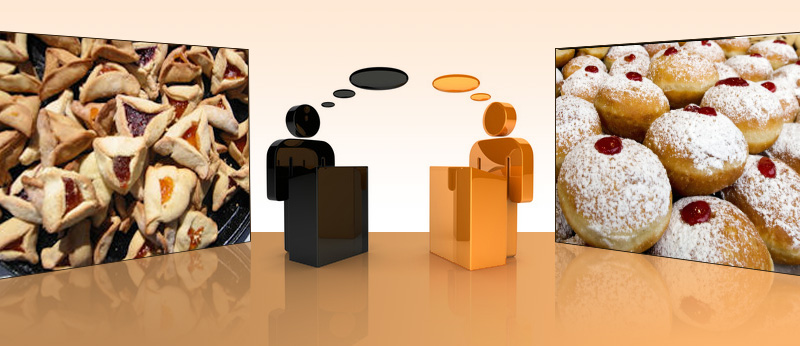
This is a debate between real scholars and it's ridiculous hilarity where some of their thinking goes, which is the whole point. The idea has likewise taken off in other universities - including such luminaries as Alan Dershowitz over at Harvard (arguing for the superiority of the hamantash). Each presentation is usually related to whatever specialty the particular professor has. For example, one latke proponent - an economist, based his argument on comparing number of Google hits since he ostensibly deals in numbers and statistics – that data "proving" the latke to be vastly superior. (Side note: It's an interesting thing to see just how many different countries come up when you put in "potato pancake". Have your kids try that one. For example, a mix version sells like hotcakes ;-) in South Korea!).
Just to be clear, there's never any winner in these events. Simply creating some sort of loopy logic is the be-all and end-all name of the game. The arguments riff off of factors like taste merits, circular versus triangular shape, which useful object or famous figure each shape resembles somehow – like due to a beard shape or hat (somehow meaning they obviously must support that side), that a latke looks like zero (or the whole world) versus a triangle being equivalent to three (or the shape of the top of many great or cool things) and the relative merits in that, not sweet vs. sweet, a debate on the better (or more "popular") ingredients involved in each…
So why not try this with your group?
- Make it a nutty class discussion and then take a vote. Or go more the semi-organized debate route. You could divvy up the class into two teams arbitrarily assigned to latke or hamentash. Either each kid presents his own added reason, or they huddle and work out an overall argument or list of reasons to be presented by 1-3 spokespersons.
Moreover, you can do this either without advance notice or alternatively give them a week's heads-up to mull over potential arguments/reasons, talk it out at home first for idea-simmering, etc. Either way, graphics are also always a fun added touch for each presenting team.
- Another option is to keep it within the chag - make it a debate of superiority between leviva/latke and sufganiyia/doughnut, or three teams- leviva vs. sufganiya vs. matbe-ot shokolad מטבעות שוקולד aka chocolate coins :-) . Of course you could be munching on the evidence during presentations too...
This obviously would work with older kids and adults, but is also likely great in one simplified form or another with even the very youngest set.
- A third option: Besides a class debate, have two groups, (or three, depending on which of the above "versus" items you choose) and make it into a broader campaign. Each group comes up with slogans and posters to hang everywhere. Place ballot boxes around for students and congregants, with short directions as to what's going on. Even encourage folks to list reasons for their choice on their ballot. Announce the winner in your newsletter or Facebook page, and if some especially fun reasons show up, post all of those too as winner arguments :) !
The Magic of Stained "Glass"
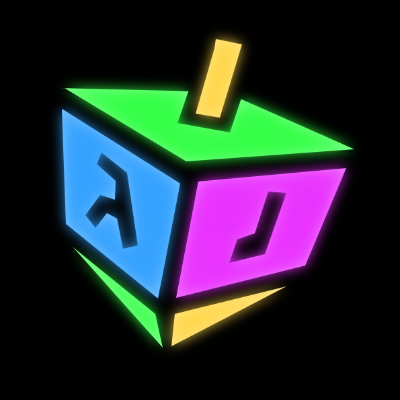 For fairly older kids you can make fancier symbols
For fairly older kids you can make fancier symbolsAfter all, what goes better with a chag about light and dark?
Here's three melechet yad / arts & crafts methods for you:
(1) To make one simple candle panel with younger children:
Black or dark construction paper (like navy blue or purple), pencil, scissors, ruler, cardboard stencils for your littlest guys- one very long rectangle + one half of a simple flame aka a roundish bump tapering to a point. Mylar sheets or old translucent binder dividers in various colors including warm ones for the flame part.
This requires two sheets of construction paper per child. Take one sheet and fold in half lengthwise. Lay the long flat edge of the flame stencil on the fold line and trace. Then trace the long rectangle underneath for the candle. Don't go as far as the top or bottom edge of your sheet of paper. While folded, cut along the trace lines. Don't open that paper yet. Take the second sheet of paper and fold in half lengthwise. Line up the first folded sheet on top of the second and trace along the cut lines onto the new sheet, which you can then cut like you did the first one, while it's folded. You now have two identical frames of a lit candle top. The kids paste colored mylar- one for flame, one for candle - onto one of the frames, then glue the other frame over that to close it and maybe add 4-6 staples for good measure. They take them home to tape in their windows and/or in class (you can make enough for both).
For fairly older kids you can make fancier symbols cut with an exacto or scissors. They just have to trace and cut for a second frame, with the mylar (or colored saran-wrap or tissue paper, etc.) glued and sandwiched inside. If using an exacto, cut on top of a protective "panel" such as a large sheet of corrugated cardboard salvaged from a big box, or perhaps a cutting board if you're doing this at home. Old cuticle shears work great too. Another alternative is to make either swirly designs or block-y subdivisions with a black Sharpie or marker on the mylar – like stained glass pieces.
***A third alternative is to write simple message words having to do with Chanukah in black marker - spaced well in the flame part - or the haiku idea we've discussed [see "And God Said Let There Be Light" in our "Let's Talk About It" section].
(2) Simple, effective oil and crayon version:
Cover your table with an oil-cloth or plastic sheet ;-) . Make an appropriate Chanukah picture, word/s, or symbol/s (see our "Handy Symbol List" above and our "Good To Know In Hebrew" section) using wax crayons on white or light-colored paper. You can do a regular picture or "stained-glass" style (depending on age and talent). Pour some vegetable oil in a small bowl, dip some cotton balls in the oil and rub it in well - all over your picture and the entire sheet so that it really saturates. The oil makes the sheet translucent. You can later remove excess oil by patting with a paper towel. Let dry for ~48 hours before hanging artwork in a window. (If still concerned about oil or stickiness, an alternative is to make the picture in the center portion of a large, cheap (aka simplest, thin, non-glossy) white paper plate. You rub the oil into just the center-circle part, which won't be touching the window when you put it up due to the curve of the plate).
(3) The glue-dip sun-catcher…
You need : white liquid glue, food coloring (yellow + red, or orange if available), spoon, small shallow bowl, pipe cleaners, play dough or clay or a rectangular soft styrofoam block (like used by florists), and waxed paper to cover your work surface.
The clay, dough or styrofoam will hold your nine pipe-cleaner "lit wicks".
Pour the glue in the bowl to a depth of at least 2-3 cm/ 1/2-1". Add some drops of food coloring to that, mix well and adjust as needed. Take each pipe-cleaner and bend at least 1/2 to 2/3 of the length into a flame shape (like a leaf). Twist the end well so that the shape is shut. Dip it into the colored glue (if it gets too thick add a tiny touch of water and re-stir well). Make certain that your shape gets completely covered by the glue. If the glue pops open, dip your flame carefully and thoroughly again. You want a slightly longer stick part for your shamash so it stands up a bit taller (or add a bit of height to that part of your clay or dough). Stick the flames gently into your clay and let dry, or dry first resting on the wax paper. Place in window :)
Back to top ⤴A Little Light Dancing & More
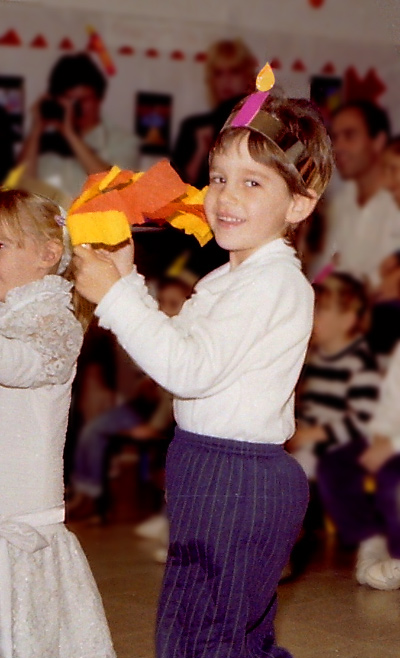 A Chanukah party in an Israeli kindergarten
A Chanukah party in an Israeli kindergartenIn Israel, our gan and grade-school kids do Chanukah presentations, often involving singing and/or simple dancing to Chanukah tapes. You would see the ubiquitous homemade flame-on-the-headband for a candle song, a sevivon headband and/or skirty thing or T-shirt with the four letters on appropriate sides for a sevivon spinning dance, a shield for a Maccabee dance, etc. On kibbutz, the older children often produce dance presentations too. If you have any youth taking breakdancing lessons, that gets really cool as well. Nowadays on Chanukah we also have all these cheap neat-o light things, odd very small light-wands with those plastic sprout-y parts at one end, glow-in-the-dark wrist bands and other what-not. Now's the time to use them. Do a dancing, spinning, glow-y light show! Or get a black-light, throw on some Chanukah music and have your kids move around to the music or play Follow The Leader while wearing white socks on their hands and maybe their feet too. How about making a simple choreographed hand dance? Or choreographed flashlight dance…
The point is that it's a good idea to co-opt anything involving light during this chag :) .
Play light games too. For example, if the weather permits or you've a large hall, play Zip-Zap (what we all did before someone invented fancy paint-ball): You play in the dark. A small number of designated folks on the side have flashlights - they try to zap people before they get to the finish line. This can be played in a cooperative version where the crossers in the dark (perhaps they are Maccabees) have the goal of getting at least one person across the finish line (or a designated limited number, if you have a much larger group) - meaning others will act as fakes and feints to divert the attention of the Zappers. (We've also played a variation where if a person manages to sneak up and tag one of the flashlighters, they have to join the other side and that's also one flashlight down).
A Super Sing-Off
We've used versions of this idea in a few other chagim packets - we just really feel it should be a regular chag tradition. Besides, the songs and word possibilities are especially good for Chanukah. Try one or more of these, using teams:

- Learn Chanukah songs. Let them know in advance that a Sing-Off is coming up (you might perhaps set the teams beforehand too). Keep large posters with lyrics up around the room. Each team aims to give the most rousing and clear performance of 2-3 songs, preferably at least one of them in Hebrew. They can get extra weight if the song is a bit harder or longer. Snaz and pizazz could also be a factor (it's "in" now, a la "Glee"). You can even give three kids the job of "Maccabiah" judges, each raising a scorecard of 1-8 (or a simpler thumbs up, sideways or down, etc.)
- Remake a popular song into a Chanukah song (but please do not use Christmas songs for this purpose).
- Create chants - and motions to go with them - that have to do with something connected to Chanukah.
- Have a Sing-Off where you have to keep coming up with more songs (any may be used, except Christmas songs and the like) - they should include a word like "light", "candle", "freedom", "free", "spin", "turn", "potato", "oil" (you can together decide on more if you like). Whichever team lasts the longest wins. The children would likely be somewhat older for this one to work well- e.g. middle school and up.
***Use some of your collected junk (from the "Chanukiah Challenge" above) to create percussion instruments and/or props in your presentation.
***You can find links to YouTubes and lyrics of some Chanukah songs in our "Cool Links" section.

